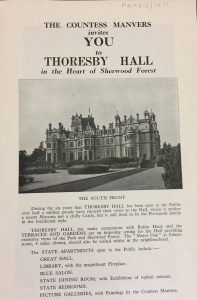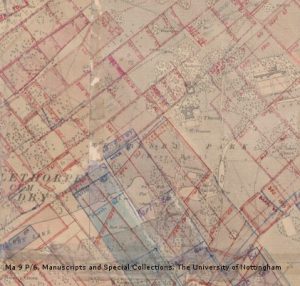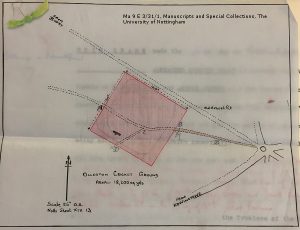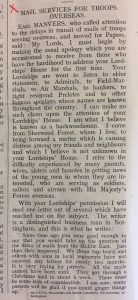September 17, 2019, by Kathryn Summerwill
New Manvers catalogue describes Thoresby in the 20th century
Newly catalogued papers in the Manvers Collection extend the story of the Thoresby Estate into the 1950s, 1960s and 1970s.
One of the largest collections held by Manuscripts and Special Collections is the Manvers Collection (Ma). It contains a record of the Pierrepont family’s landed estates, based at Holme Pierrepont and Thoresby, from the mid-seventeenth century onwards. The first deposit of material was received by the University Library in 1948, and we now hold nearly 900 boxes of material and over 600 flat maps and plans. The archive provides an almost continuous account of the administration of the estate over the years, including a fine series of estate accounts from 1678 to 1950.
Up to now, researchers using the Manvers Collection (Ma-Ma 8) could find evidence of the running of the estate until the Second World War. In common with other landed families, the Pierreponts were forced to sell outlying properties from the 1910s to the 1930s. The family were forced to sell the Holme Pierrepont estate because of the cost of death duties following the death of the 5th Earl Manvers in 1940. The ancestral property at Holme near Nottingham had been brought into the family by the marriage of Henry de Pierrepont and Annora de Manvers at the end of the 13th century. By 1950 the estate was focused around the family’s other key residence, Thoresby Hall in the Dukeries.
We have now released detailed descriptions of Ma 9, a series of estate records. Ma 9 contains 64 boxes of material, the bulk of which represents the filing system of the Thoresby Estate Office. The archives were created in the course of daily business by the estate agents Hubert Argles (1913-1949), Colonel Denzil Holder (1949-1955), Hugh Tapper (1955-1974), and R. McFerran.
Highlights from Ma 9 – Thoresby Hall
The family first opened Thoresby Hall to members of the public in 1957. A subject file about the seasonal opening (Ma 9 E 3/18) contains a printed leaflet entitled ‘The Countess Manvers invites YOU to Thoresby Hall in the Heart of Sherwood Forest’, produced in around 1963. You could choose to eat at a variety of places during your visit. A separate leaflet of the same date advertises two licenced restaurants: the Maid Marian Restaurant, and the Robin Hood Restaurant. There was also the Friar Tuck Snack Bar, and a Tea Garden adjoining the cricket ground. Afternoon Tea was priced at 3 shillings. A hot luncheon priced at 7 shillings and 6 pence gave you grilled steak or chop, chipped potatoes, 2 vegetables, sweet or biscuits and cheese. A cold luncheon for 5 shillings and 6 pence contained ham and tongue salad, bread and butter, fruit and ice cream sundae or biscuits and cheese.
By the mid-twentieth century, subsidence from mine workings underneath the Thoresby estate was threatening the structure of Thoresby Hall. There are files of correspondence and reports, dated 1958-1971, relating to a claim made to the National Coal Board (NCB) for compensation for the damage caused (Ma 9 E 3/5/1-9). Thoresby Hall was sold to the NCB in 1980, but certain rooms in the property were leased back to Countess Manvers (who remained there until her death in 1984) and the Thoresby trustees. The contents of the Hall were sold in 1989, and the collection contains various papers and inventories relating to the sale (Ma 9 I 1/1-10). We also have a remarkable map of the area around Thoresby Hall, showing the creep of mine workings towards the Hall during the 1980s (Ma 9 P/6). The colours on the map show the coal seams: High Hazel (highest) in green; Barnsley Hard (middle) in pink; Park Gate (deepest) in blue. At one time, the Thoresby estate used this map on a weekly basis to try to predict mining subsidence.
Highlights from Ma 9 – the estate and its owners
Leases, tenancy agreements and farm tenancy files are a record of the daily work of running a landed estate. The files contain correspondence with farmers about improvements to their farm houses or farm buildings, rent revisions, and other business concerns. As well as farms and residential tenancies, the Thoresby Estate leased out business premises and public amenities. One example is the lease of land at Ollerton Corner to the Ollerton Cricket Club. The draft lease gives the names of the club committee members and the terms and conditions of the lease.
There are only a few records of the owners of the estate themselves. Gervas Evelyn Pierrepont succeeded as 6th Earl Manvers in 1940. The following year, he made his maiden speech in the House of Lords. He was concerned with the wartime problem of getting letters to and from troops serving overseas. Describing himself as “what I believe is known as a backwoodsman” (rather disingenously, as he had lived in the capital and served on the London County Council in the 1920s!), Pierrepont added, “I come from Sherwood Forest, where I live, to bring forward a matter which is causing distress among my friends and neighbours.” A complete set of his speeches and questions in the House of Lords, printed in Hansard, the House of Lords Official Reports, was gathered together and annotated by his widow Marie-Louise Roosevelt Pierrepont, the final Countess Manvers (Ma 9 F 7/1/1-29).
The title of Earl Manvers became extinct on the 6th Earl’s death in 1955. His only surviving child, Lady Rozelle Raynes (1925-2015), inherited the estate. Lady Rozelle lived mostly in London and Devon. The records in Ma 9 reveal the skill of the Thoresby Estate agents and trustees in making the estate a success despite the wide geographical spread of the principal stakeholders during this time.
The Manvers Collection is catalogued in detail on the Manuscripts Online Catalogue. More information about the collection is available on our website. Items from the collection are available to view in the Reading Room on King’s Meadow Campus. To make an appointment please contact us.
No comments yet, fill out a comment to be the first





Leave a Reply